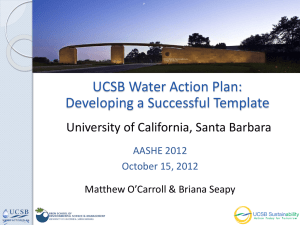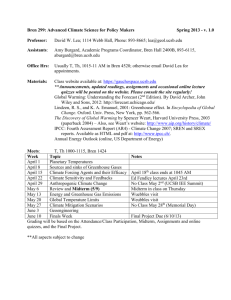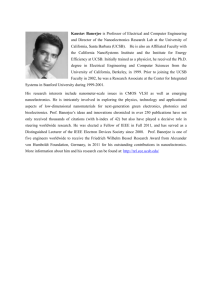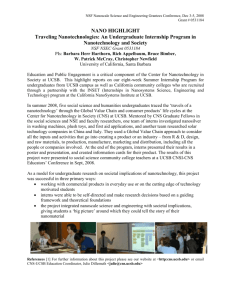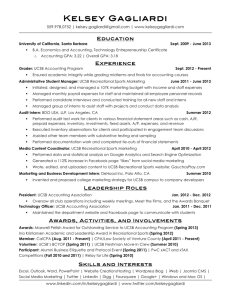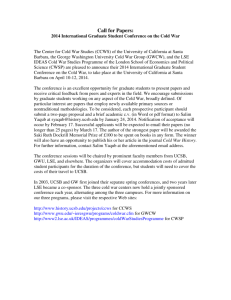case study - Green Building Research Center (GBRC)
advertisement
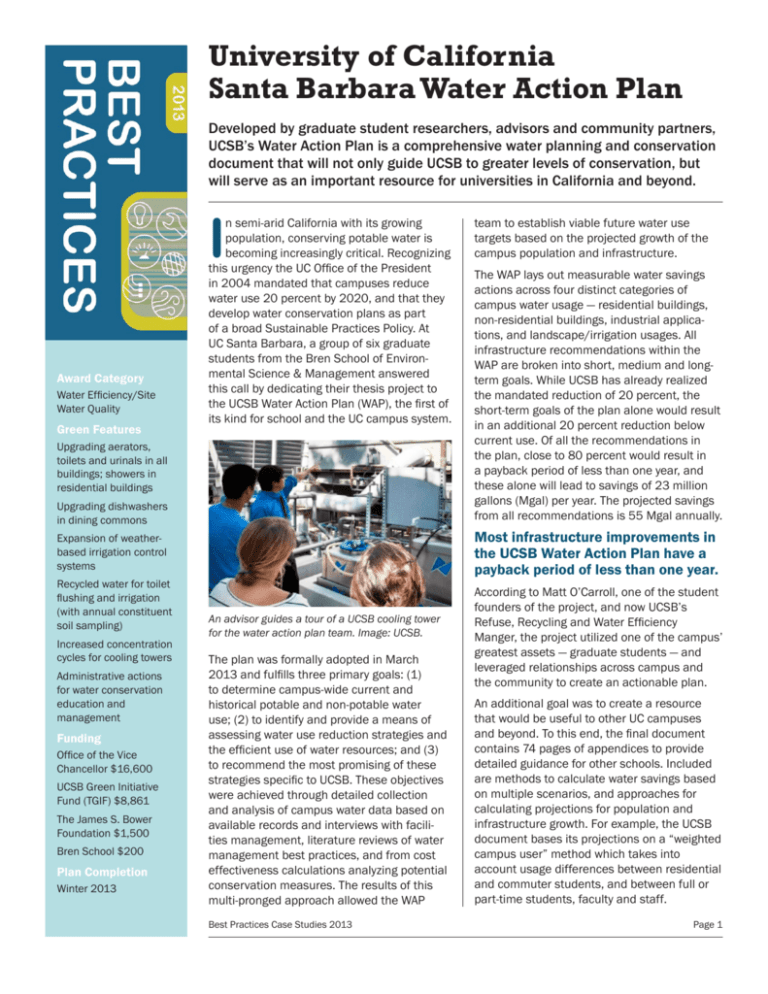
University of California Santa Barbara Water Action Plan Developed by graduate student researchers, advisors and community partners, UCSB’s Water Action Plan is a comprehensive water planning and conservation document that will not only guide UCSB to greater levels of conservation, but will serve as an important resource for universities in California and beyond. I Award Category Water Efficiency/Site Water Quality Green Features n semi-arid California with its growing population, conserving potable water is becoming increasingly critical. Recognizing this urgency the UC Office of the President in 2004 mandated that campuses reduce water use 20 percent by 2020, and that they develop water conservation plans as part of a broad Sustainable Practices Policy. At UC Santa Barbara, a group of six graduate students from the Bren School of Environmental Science & Management answered this call by dedicating their thesis project to the UCSB Water Action Plan (WAP), the first of its kind for school and the UC campus system. Upgrading aerators, toilets and urinals in all buildings; showers in residential buildings Upgrading dishwashers in dining commons Increased concentration cycles for cooling towers Administrative actions for water conservation education and management Funding Office of the Vice Chancellor $16,600 UCSB Green Initiative Fund (TGIF) $8,861 The James S. Bower Foundation $1,500 Bren School $200 Plan Completion Winter 2013 The WAP lays out measurable water savings actions across four distinct categories of campus water usage — residential buildings, non-residential buildings, industrial applications, and landscape/irrigation usages. All infrastructure recommendations within the WAP are broken into short, medium and longterm goals. While UCSB has already realized the mandated reduction of 20 percent, the short-term goals of the plan alone would result in an additional 20 percent reduction below current use. Of all the recommendations in the plan, close to 80 percent would result in a payback period of less than one year, and these alone will lead to savings of 23 million gallons (Mgal) per year. The projected savings from all recommendations is 55 Mgal annually. Most infrastructure improvements in the UCSB Water Action Plan have a payback period of less than one year. Expansion of weatherbased irrigation control systems Recycled water for toilet flushing and irrigation (with annual constituent soil sampling) team to establish viable future water use targets based on the projected growth of the campus population and infrastructure. An advisor guides a tour of a UCSB cooling tower for the water action plan team. Image: UCSB. The plan was formally adopted in March 2013 and fulfills three primary goals: (1) to determine campus-wide current and historical potable and non-potable water use; (2) to identify and provide a means of assessing water use reduction strategies and the efficient use of water resources; and (3) to recommend the most promising of these strategies specific to UCSB. These objectives were achieved through detailed collection and analysis of campus water data based on available records and interviews with facilities management, literature reviews of water management best practices, and from cost effectiveness calculations analyzing potential conservation measures. The results of this multi-pronged approach allowed the WAP Best Practices Case Studies 2013 According to Matt O’Carroll, one of the student founders of the project, and now UCSB’s Refuse, Recycling and Water Efficiency Manger, the project utilized one of the campus’ greatest assets — graduate students — and leveraged relationships across campus and the community to create an actionable plan. An additional goal was to create a resource that would be useful to other UC campuses and beyond. To this end, the final document contains 74 pages of appendices to provide detailed guidance for other schools. Included are methods to calculate water savings based on multiple scenarios, and approaches for calculating projections for population and infrastructure growth. For example, the UCSB document bases its projections on a “weighted campus user” method which takes into account usage differences between residential and commuter students, and between full or part-time students, faculty and staff. Page 1 Contacts UCSB Refuse, Recycling and Water Efficiency Manager: Matthew O’Carroll matthew.ocarroll@ pf.ucsb.edu Team Project Managers: Matthew O’Carroll, Briana Seapy and Kathryn Cole Financial Manager: Jewel Snavely Data Manager: Dane Johnson: Website Manager: Rebecca Dorsey Faculty Advisor: Derek Booth External Advisors and Advisory Committee Bren School of Environmental Science & Management: Arturo Keller and Bob Wilkinson UCSB Physical Facilities: Jordan Sager Goleta Water District: Chris Rich UCSB Client Representative: Mo Lovegreen More Information UCSB Water Action Plan: http://www2.bren.ucsb. edu/~wateraction/ UCOP Sustainable Practices Policy website: http://sustainability. universityofcalifornia. edu/policy.html All infrastructure related improvements in the WAP were evaluated based on economic assessments, and were identified in terms of implementation time frames for short, medium, or long-term horizons. The relatively high cost of water in this locality makes a simple return-on-investment (ROI) business case for these upgrades compelling. However, this may not be the case everywhere, and as such, environmental and resource conservation motives must be widely viewed as a sufficiently strong motivation in itself. The document contains extensive appendices to serve as templates for other campuses, and key planning documents are available online. The estimated cost saving of all infrastructure related recommendations contained within the WAP is $250,000 per year with an average payback of less than seven years. Under the guidance of the plan, UCSB has already committed $48,000 to new water conservation measures including retrofits to inefficient bathroom fixtures and the installation of new water meters. These two projects alone are expected to provide water savings of 23 Mgal per year with a cost payback of less than one year. In addition to the quantitative infrastructural changes, the WAP also proposes qualitative changes that focus primarily on education among campus water users, and policy changes at the campus level. The sum of savings from these actions is projected to be 1.2 Mgal per year. First and foremost, the plan is structured as a roadmap for implantation with detailed guidance and water conservation measures for all facets of campus operations projected for 15 years into the future. The document’s structure was modeled after the Environmental Protection Agency’s framework of “Plan-DoCheck-Act” and includes checkpoints after two and five years to monitor whether goals are being met. The WAP authors hope that the document will allow the campus to effectively prioritize and identify needed changes, to enact appropriate and feasible implementation strategies, and to respond effectively to inevitable changes over time. In response to management recommendations contained in the document, the campus has already created a new position to shepherd implementation of the conservation measures and to further the collaborative environment that was established during the creation of the plan. Project team members including faculty advisor Derek Booth (at left) and graduate students from the Bren School. Image: Dane Johnson. LESSONS LEARNED Matthew O’Carroll explains that the experience drew together stakeholders from various campus and community interests. The project fostered collaboration from the outset with faculty and staff members from the Bren School, Facilities Management, Utility and Energy Services, and Landscape and Custodial Services who all provided input and expertise to insure the practicability of all recommendations. In addition, wider input was sought from the local water and sanitary districts. O’Carroll stresses that sharing the process and methods that went into the plan with others can result in better outcomes across a wider community of stakeholders. Best Practices case studies are coordinated by the Green Building Research Center, at the University of California, Berkeley. The Best Practices Competition showcases successful projects on UC and CSU campuses to assist campuses in achieving energy efficiency and sustainability goals. Funding for Best Practices is provided by the UC/CSU/IOU Energy Efficiency Partnership. Best Practices Case Studies 2013 Page 2
